Furniture conforming to...? Jere Osgood
Traditionally, furniture was designed to conform to the human body and what was being worn at the time. That’s why we see low side chairs with no arms during the mid-1800s when women were wearing huge crinolines (hoop skirts) or bustles. During the middle ages (ca. 500–1100 CE) in the West, low benches were elaborately carved, included storage, and were used not only for sitting but also sleeping. Furniture in China, Korea, and Japan combined utility with comfort. Since the Arts and Crafts movement of the late 1800s to early 1900s—which stressed aesthetics as well as utility— furniture has, in my mind, come to rival sculpture as an art form.
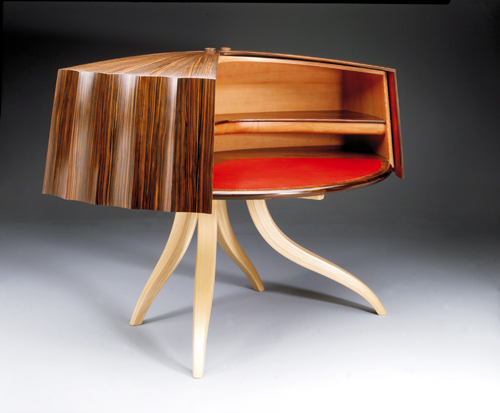 |
| Jere Osgood (born 1936, United States), Ebony Desk, 1990. Macassar ebony, Australian lacewood, Padauk, pearwood, ash, and leather. Mint Museum, Charlotte, NC. © 2013 Jere Osgood. (MIN-64) |
Jere Osgood studied both architecture and furniture design at the School for American Craftsmen. In 1975 he established the Woodworking Department at the Artisanry Program of Boston University. Osgood credits the study of architecture for his furniture design method. It imitates the stages of designing a building: choosing the materials and coming up with a complete design. His use of laminates(thin pieces of bent wood) and his emphasis on the bent wood process— in which steam helps slowly curve a straight piece of wood—have had a profound impact on contemporary furniture designers. This beautiful desk combines a sophisticated laminate process (the “draped” top that belies the nature of the wood), and bent wood process in the legs.
Many American museums encourage exhibitions of contemporary furniture design. The result is always exciting. I’m thinking of the shows I’ve seen at the MFA in Boston, the Museum of Modern Art in New York, the Art Institute of Chicago, and at the Philadelphia Museum of Art. What always strikes me is that a lot of contemporary furniture design adheres to principles that were established in the late 1800s by Arts and Crafts movement artists, and then a little later by Bauhaus artists in Germany (ca. 1919–1933). They believed that utilitarian objects, such as furniture, could be not only functional, but aesthetically pleasing. I think you’ll agree when you look at my choices of bent wood furniture!
Other furniture artists who work with bent wood and laminates:
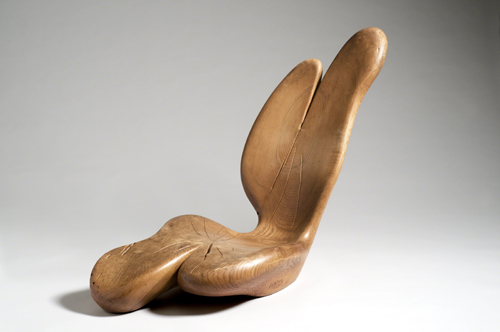 |
| Jon Brooks (born 1944, United States), “Ansouis” Chair, 1978. White ash, 40" x 24" x 48" (101.6 x 61 x 121.9 cm). Philadelphia Museum of Art. © 2013 Jon Brooks. (PMA-4156) |
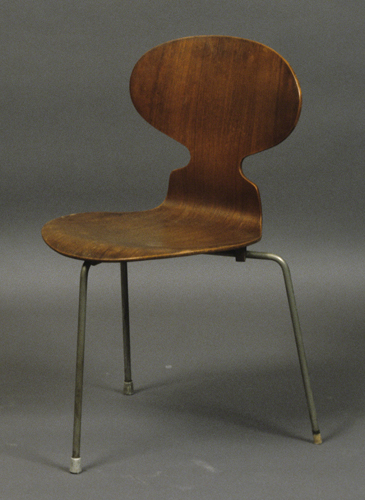 |
| Arne Jacobsen (designer, 1902–1971, Denmark) and Fritz Hansen (maker, firm established 1872, Copenhagen), Ant Chair, 1951. Molded plywood with metal legs, 30 3/8" x 20 1/4" x 19 3/8" (77.1 x 51.5 x 49.2 cm). Cleveland Museum of Art. © 2013 Estate of Arne Jacobsen. (CL-490) |
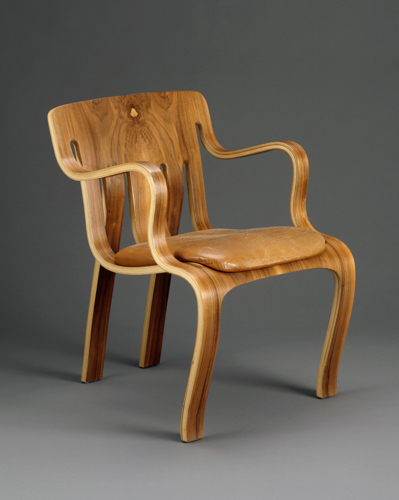 |
| Peter Danko (born 1949, United States), Armchair, 1982. Walnut veneer, poplar, leather upholstery; 30 1/2" x 21 3/4" x 24" (77.47 x 55.24 x 60.96 cm). Museum of Fine Arts, Boston. © 2013 Peter Danko. (MFAB-496) |
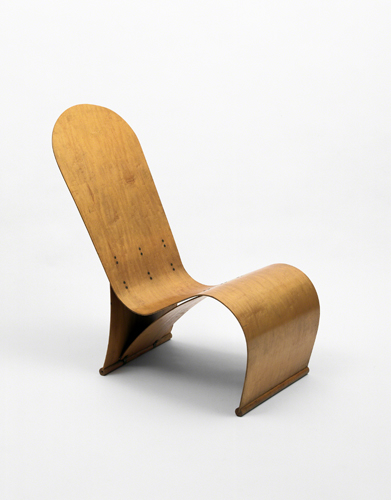 |
| Herbert van Thaden and Donald Lewis Jordan (active mid-20th century) for Thaden Jordan Furniture Company, Experimental Plywood Recliner, 1947. Plywood, 36" x 19 3/4" (91.4 x 50.2 cm). © Museum of Modern Art, New York. (MOMA-D0860) |
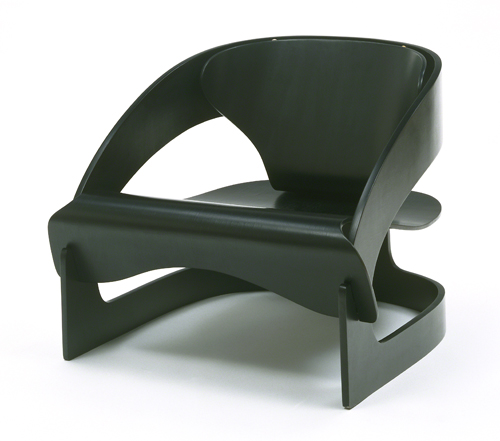 |
| Joe Colombo (designer, 1930–1971, Italy) and Kartell S.p.A. (maker, firm founded 1949, Milan region), Lounge Chair, 1964. Molded plywood and polyester lacquer, 23 1/8" x 27 3/4" x 24 3/4" (58.7 x 70.5 x 62.9 cm). Museum of Modern art, New York. © 2013 Estate of Joe Colombo. (MOMA-D0087) |
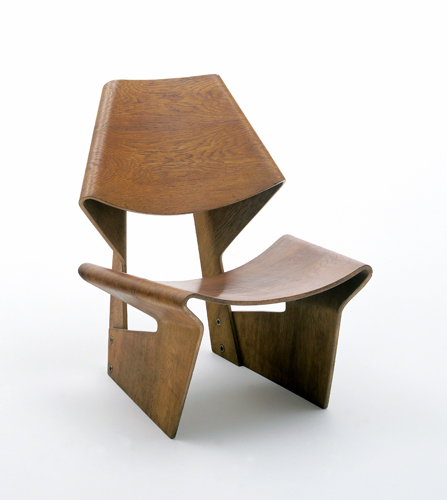 |
| Grete Jalk (designer 1920–2006, Denmark) and Poul Jeppesen (maker, 1909–1986, Denmark), Lounge Chair, 1963. Teak, 29 1/2" x 24 3/4" x 24 3/4" (74.9 x 62.9 x 69.2 cm). Museum of Modern Art, New York. © Estate of Grete Jalk. (MOMA-D0808) |
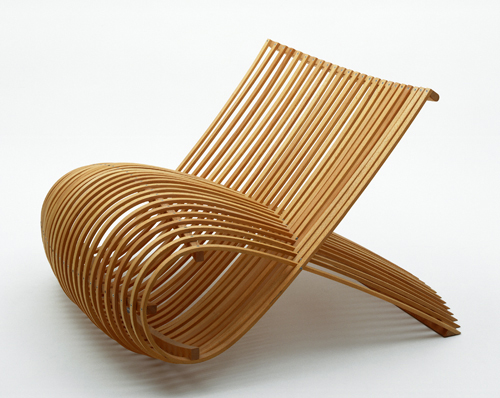 |
| Marc Newson (designer, born 1963, Australia) and Cappellini S.p.A. (manufacturer; firm founded 1946; Arosio, Italy), Wood Chair, 1988. Beech, 34 3/8" x 32 1/2" x 39 3/4" (61.9 x 82.6 x 101 cm). Museum of Modern Art, New York. © 2013 Marc Newson. (MOMA-D0392) |
Many artists who are architects also design furniture:
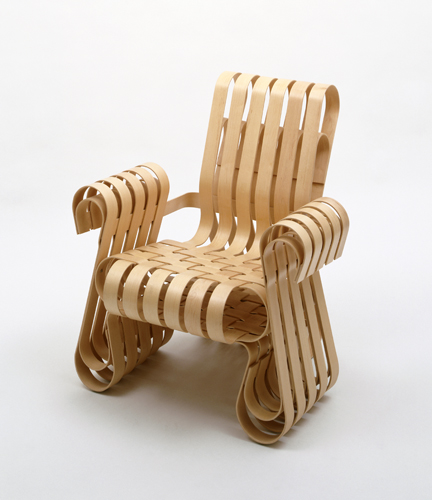 |
| Frank Gehry (designer, born 1929, United States) and Knoll (manufacturer, firm founded 1937, New York), Power Play Armchair, 1991. Bent-laminated maple, 32 3/4" x 30 1/2" x 31 1/2" (83.2 x 77.5 x 80 cm). Museum of Modern Art, New York. © 2013 Frank Gehry. (MOMA-D0497) |
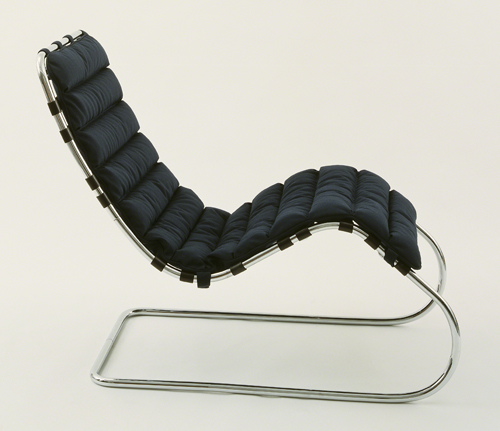 |
| Ludwig Mies van der Rohe (designer, 1886–1969, Germany/United States) and Bamberg Metallwerkstätten (maker, firm established 1931, Berlin), MR Chaise Longue (model 104), 1931. Chrome-plated tubular steel with contour canvas cushion, 37 1/2" x 23 1/2" x 47 1/2" (95.3 x 59.8 x 119.9 cm). Museum of Modern Art, New York. © 2013 Estate of Ludwig Mies van der Rohe / Artists Rights Society (ARS), New York. (MOMA-D0067mvdars). |
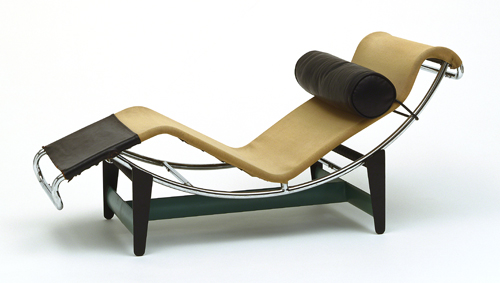 |
| Le Corbusier (Charles-Édouard Jeanneret) (designer, 1887–1965, Switzerland) and Thonet Frères (maker, firm founded 1929, Paris), Chaise Longue, 1927. Chrome-plated tubular steel, painted steel, fabric, and leather; 24" x 19 5/8" x 62 1/4" (61 x 50 x 158 cm). Museum of Modern Art, New York. © 2013 Estate of Le Corbusier / Artists Rights Society (ARS), New York. (MOMA-D0076lcars) |
Studio activity: Design a chair that reflects contemporary life. Consider how a chair could conform to the way people dress, sit, or rest. Use pencil, colored pencil, or color markers to design the chair. The chair could reflect the surroundings (be it urban or rural) or personal preferences—such as well padded or strictly geometric.
Correlations to Davis programs: Explorations in Art Grade 2: 35-36 studio, Explorations in Art Grade 4: studio 15 and 16, The Visual Experience: 12.4, Discovering Art History: 2.2


Comments